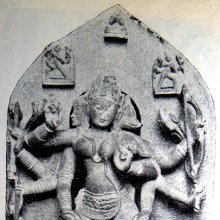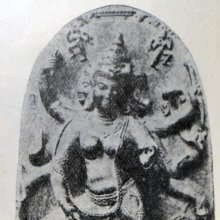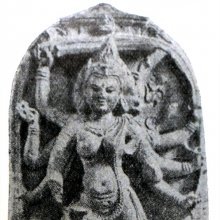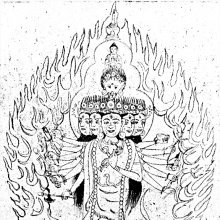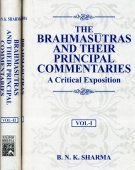Hiranyagarbha, Hiraṇyagarbha, Hiranya-garbha: 21 definitions
Introduction:
Hiranyagarbha means something in Hinduism, Sanskrit, Jainism, Prakrit, the history of ancient India. If you want to know the exact meaning, history, etymology or English translation of this term then check out the descriptions on this page. Add your comment or reference to a book if you want to contribute to this summary article.
Images (photo gallery)
In Hinduism
Vaishnavism (Vaishava dharma)
Source: humindian: 108 names of Lord KrishnaOne of the 108 names of Krishna; Meaning: "The All Powerful Creator"

Vaishnava (वैष्णव, vaiṣṇava) or vaishnavism (vaiṣṇavism) represents a tradition of Hinduism worshipping Vishnu as the supreme Lord. Similar to the Shaktism and Shaivism traditions, Vaishnavism also developed as an individual movement, famous for its exposition of the dashavatara (‘ten avatars of Vishnu’).
Shaivism (Shaiva philosophy)
Source: Manblunder: Sri Rudram 2.1-2Hiraṇyagarbha (हिरण्यगर्भ):—The souls originated from the hiraṇyagarbha or the golden egg. This is so called, as it is born from a golden egg, formed out of the seed deposited in the waters when they were produced as the first creation of the Self-existent This seed became a golden egg, resplendent as the sun, in which the Self-existent Brahma was born as Brahmā the Creator, who is therefore regarded as a manifestation of the Self-existent.
Source: eScholarship: The descent of scripture: a history of the KamikagamaHiraṇyagarbha (हिरण्यगर्भ) or Hiraṇyagarbhadāna refers to the “gift of the golden embryo”, according to the Kāmikāgama: an ancient Śaiva Āgama scripture in 12,000 Sanskrit verses dating to at least the 5th century and represented as an encyclopedic account of ritual instructions (kriyāpāda).—In modern print editions, the Kāmika-āgama is structured in two major parts. The Uttarabhāga consists of 98 chapters (paṭalas) [...] The concluding chapters (from Chapter 83 to 98) describe sixteen major types of gifting, which are comparable to similar treatments of gifting laid out in Dharmaśāstra literature. The gifts include the following: [...] The gift of the golden embryo (hiraṇyagarbha-dāna, Chapter 84); [...]

Shaiva (शैव, śaiva) or Shaivism (śaivism) represents a tradition of Hinduism worshiping Shiva as the supreme being. Closely related to Shaktism, Shaiva literature includes a range of scriptures, including Tantras, while the root of this tradition may be traced back to the ancient Vedas.
Purana and Itihasa (epic history)
Source: archive.org: Puranic EncyclopediaHiraṇyagarbha (हिरण्यगर्भ).—A synonym of Śrī Kṛṣṇa. (Śānti Parva, Chapter 342, Verse 96).
Source: archive.org: Shiva Purana - English TranslationHiraṇyagarbha (हिरण्यगर्भ) refers to the “gold-wombed lord” and is used to describe Śiva, according to the Śivapurāṇa 2.5.2 (“The Prayer of the gods).—Accordingly, as the Gods eulogized Śiva: “Obeisance to the gold-wombed lord (hiraṇyagarbha), the creator of everything. Obeisance to Thee, the sustainer, the omnipresent and the omnipotent. Obeisance to Thee of destroyer’s form, the annihilator of living beings. Obeisance to Thee devoid of attributes, and of immeasurable splendour. Obeisance to Thee devoid of states, possessed of splendour and free from aberrations; obeisance to Thee of the soul of Great Elements; obeisance to the unsullied, the great Ātman. [...]”.
Source: Cologne Digital Sanskrit Dictionaries: The Purana Index1a) Hiraṇyagarbha (हिरण्यगर्भ).—Is Brahmā.*
- * Brahmāṇḍa-purāṇa III. 1. 35; 65. 23.
1b) Is Vāsudeva;1 as the author of Yogaśāstra.2

The Purana (पुराण, purāṇas) refers to Sanskrit literature preserving ancient India’s vast cultural history, including historical legends, religious ceremonies, various arts and sciences. The eighteen mahapuranas total over 400,000 shlokas (metrical couplets) and date to at least several centuries BCE.
Pancaratra (worship of Nārāyaṇa)
Source: archive.org: Catalogue of Pancaratra Agama TextsHiraṇyagarbha (हिरण्यगर्भ) is another name for Brahmā, according to the fourth chapter of the Agastyasaṃhitā (agastya-suīkṣṇa-saṃvāda edition), an ancient Pāñcarātra Āgama text dealing with the worship of Rāma, Sītā, Lakṣmaṇa and Hanumān.—Description of the chapter [mantraprāptiprakāra]: “Pārvatī asks Śiva to explain what manner of devout meditation [upāsanā] it was that those sages engaged in, the effects of which brought Nārāyaṇa down into the form of Rāma and thus brought salvation within reach of all. Śiva explains that the sages mentioned before were led by Hiraṇyagarbha (=Brahmā) who, by means of that great penance [tapas] and praise [stotra] over a number of years, succeeded in seeing Nārāyaṇa; indeed, he was the first one to whom Nārāyaṇa appeared. [...]”.
Source: Shodhganga: Iconographical representations of Śiva (pancaratra)Hiraṇyagarbha (हिरण्यगर्भ) or Hiraṇyagarbhasaṃhitā is the name of a Vaiṣṇava Āgama scripture, classified as a sāttvika type of the Muniprokta group of Pāñcarātra Āgamas. The vaiṣṇavāgamas represent one of the three classes of āgamas (traditionally communicated wisdom).—Texts of the Pāñcara Āgamas are divided in to two sects. It is believed that Lord Vāsudeva revealed the first group of texts which are called Divya and the next group is called Muniprokta which are further divided in to three viz. a. Sāttvika (e.g., Hiraṇyagarbha-saṃhitā). b. Rājasa. c. Tāmasa.

Pancaratra (पाञ्चरात्र, pāñcarātra) represents a tradition of Hinduism where Narayana is revered and worshipped. Closeley related to Vaishnavism, the Pancaratra literature includes various Agamas and tantras incorporating many Vaishnava philosophies.
General definition (in Hinduism)
Source: Google Books: TattvabodhaAll the souls put together is the Brahman. In the same way, all the subtle bodies put together, is known as hiraṇyagarbha or the cosmic egg. Hiraṇyagarbha is endowed with intellect and this intellect, also known as mahat, is the cause for the physical body. Hiraṇyagarbha can be considered as the feminine energy, if soul is considered as the masculine energy. Unless, the soul impregnates hiraṇyagarbha, creation is not possible.
In Jainism
General definition (in Jainism)
Source: archive.org: TrisastisalakapurusacaritraHiraṇyagarbha (हिरण्यगर्भ) is the son of Citramālā and Sukośala (son of Sahadevī and Kīrtidhara), according to the Jain Ramayana and chapter 7.4 [Rāma and Lakṣmaṇa] of Hemacandra’s 11th century Triṣaṣṭiśalākāpuruṣacaritra: an ancient Sanskrit epic poem narrating the history and legends of sixty-three illustrious persons in Jainism.—Accordingly, “Now Citramālā, King Sukośala’s wife, bore a son, Hiraṇyagarbha, the joy of the family. When he, who had been king from the time he was in the womb, grew up, gazelle-eyed Mṛgāvatī became his wife. Mṛgāvatī bore King Hiraṇyagarbha a son named Naghuṣa, like another (Naghuṣa) in form. One day, Hiraṇyagarbha saw a gray hair on his head, which was like a pledge of approaching old age. Feeling disgust with existence immediately, the king installed his son Naghuṣa on the throne and took the vow under Muni Vimala. [...]”.

Jainism is an Indian religion of Dharma whose doctrine revolves around harmlessness (ahimsa) towards every living being. The two major branches (Digambara and Svetambara) of Jainism stimulate self-control (or, shramana, ‘self-reliance’) and spiritual development through a path of peace for the soul to progess to the ultimate goal.
India history and geography
Source: Cologne Digital Sanskrit Dictionaries: Indian Epigraphical GlossaryHiraṇyagarbha.—(EI 16; IA 10; SII 3), name of a mahādāna. Note: hiraṇyagarbha is defined in the “Indian epigraphical glossary” as it can be found on ancient inscriptions commonly written in Sanskrit, Prakrit or Dravidian languages.

The history of India traces the identification of countries, villages, towns and other regions of India, as well as mythology, zoology, royal dynasties, rulers, tribes, local festivities and traditions and regional languages. Ancient India enjoyed religious freedom and encourages the path of Dharma, a concept common to Buddhism, Hinduism, and Jainism.
Languages of India and abroad
Sanskrit dictionary
Source: DDSA: The practical Sanskrit-English dictionaryHiraṇyagarbha (हिरण्यगर्भ).—
1) Name of Brahman (as born from a golden-egg).
2) Name of Viṣṇu.
3) the soul invested by the subtile body or सूक्ष्मशरीर (sūkṣmaśarīra) q. v.
Derivable forms: hiraṇyagarbhaḥ (हिरण्यगर्भः).
Hiraṇyagarbha is a Sanskrit compound consisting of the terms hiraṇya and garbha (गर्भ).
Source: Cologne Digital Sanskrit Dictionaries: Edgerton Buddhist Hybrid Sanskrit DictionaryHiraṇyagarbha (हिरण्यगर्भ).—name of a king: (Ārya-)Mañjuśrīmūlakalpa 622.7.
Source: Cologne Digital Sanskrit Dictionaries: Shabda-Sagara Sanskrit-English DictionaryHiraṇyagarbha (हिरण्यगर्भ).—m.
(-rbhaḥ) 1. Brahma. 2. Vishnu. 3. The soul invested by the subtile body, “sūkṣmaśarīra”. E. hiraṇya gold, garbha embryo; or the mundane egg floating on the water at creation, of that metal, or of similar colour, from which the deity issued, according to some legends.
Source: Cologne Digital Sanskrit Dictionaries: Benfey Sanskrit-English DictionaryHiraṇyagarbha (हिरण्यगर्भ).—m. Brahman.
— Cf. [Gothic.] kalbo; A. S. calf.
Hiraṇyagarbha is a Sanskrit compound consisting of the terms hiraṇya and garbha (गर्भ).
Source: Cologne Digital Sanskrit Dictionaries: Cappeller Sanskrit-English DictionaryHiraṇyagarbha (हिरण्यगर्भ).—[masculine] golden womb or fetus, [Epithet] of Brahman.
Source: Cologne Digital Sanskrit Dictionaries: Aufrecht Catalogus CatalogorumHiraṇyagarbha (हिरण्यगर्भ) as mentioned in Aufrecht’s Catalogus Catalogorum:—father of Ratnagarbha (Viṣṇupurāṇaṭīkā). L. 2573.
Source: Cologne Digital Sanskrit Dictionaries: Monier-Williams Sanskrit-English Dictionary1) Hiraṇyagarbha (हिरण्यगर्भ):—[=hiraṇya-garbha] [from hiraṇya > hiraṇa] m. a golden fetus, [Catalogue(s)]
2) [v.s. ...] Name of Brahmā (so called as born from a golden egg formed out of the seed deposited in the waters when they were produced as the first creation of the Self-existent; according to, [Manu-smṛti i, 9], this seed became a golden egg, resplendent as the sun, in which the Self-existent Brahma was born as Brahmā the Creator, who is therefore regarded as a manifestation of the Self-existent, [Ṛg-veda x, 121]), [Ṛg-veda; Atharva-veda; Śatapatha-brāhmaṇa] etc. (cf. [Religious Thought and Life in India 14 etc.])
3) [v.s. ...] Name of the author of the hymn Ṛgveda[ x, 121] (having the [patronymic] Prājāpatya), [Anukramaṇikā]
4) [v.s. ...] of a Vedānta teacher, [Tattvasamāsa]
5) [v.s. ...] of various other persons, [Catalogue(s)]
6) [v.s. ...] of Viṣṇu, [Mahābhārata]
7) [v.s. ...] of a flamingo, [Hitopadeśa]
8) [v.s. ...] (in [philosophy]) the soul invested with the Sūkṣma-śarīra or subtle body (= sūtrātman, prāṇātman), [Vedāntasāra]
9) Hiraṇyagarbhā (हिरण्यगर्भा):—[=hiraṇya-garbhā] [from hiraṇya-garbha > hiraṇya > hiraṇa] f. Name of a river, [Catalogue(s)]
10) Hiraṇyagarbha (हिरण्यगर्भ):—[=hiraṇya-garbha] [from hiraṇya > hiraṇa] n. ([probably]) Name of a Liṅga, [ib.]
11) [v.s. ...] mfn. relating to Hiraṇya-garbha or Brahmā, [Indische Studien by A. Weber]
Source: Cologne Digital Sanskrit Dictionaries: Yates Sanskrit-English DictionaryHiraṇyagarbha (हिरण्यगर्भ):—[hiraṇya-garbha] (rbhaḥ) 1. m. Brahmā.
[Sanskrit to German]
Sanskrit, also spelled संस्कृतम् (saṃskṛtam), is an ancient language of India commonly seen as the grandmother of the Indo-European language family (even English!). Closely allied with Prakrit and Pali, Sanskrit is more exhaustive in both grammar and terms and has the most extensive collection of literature in the world, greatly surpassing its sister-languages Greek and Latin.
Kannada-English dictionary
Source: Alar: Kannada-English corpusHiraṇyagarbha (ಹಿರಣ್ಯಗರ್ಭ):—
1) [noun] gold.
2) [noun] a container, vessel made of gold.
3) [noun] silver.
4) [noun] any precious metal.
5) [noun] riches; wealth.
6) [noun] the viscid, whitish fluid produced in the male reproductive organs, containing spermatozoa; the semen.
7) [noun] the glossy shell of any of number of gastropods; a cowrie.
8) [noun] the seed capsule of Datura stramonium.
9) [noun] a gold coin.
10) [noun] name of one of the seven flames of a fire.
Kannada is a Dravidian language (as opposed to the Indo-European language family) mainly spoken in the southwestern region of India.
See also (Relevant definitions)
Partial matches: Hiranya, Garbha.
Starts with: Hiranyagarbhadana, Hiranyagarbhadanaprayoga, Hiranyagarbhadanavidhi, Hiranyagarbhahridaya, Hiranyagarbhangabhu, Hiranyagarbhaparasharasamhitayam, Hiranyagarbhapottali, Hiranyagarbhasamhita, Hiranyagarbhasamhitayam, Hiranyagarbhasamhitayam ramacandranamashtottarashatam, Hiranyagarbhatantra, Hiranyagarbhavati, Hiranyagarbhavidhi.
Full-text (+58): Hairanyagarbha, Hiranyagarbhasamhita, Hiranyagarbhavati, Hiranyagarbhadanaprayoga, Hiranyagarbhadana, Hiranyagarbhahridaya, Hiranyagarbhatantra, Hiranyagarbhadanavidhi, Hiranyagarbhavidhi, Iraniya-karppatanam, Hiranyagarbhangabhu, Hemagarbha, Svarnagarbha, Sukala, Vishesha, Tamaniyan, Brahmatejomaya, Pranatman, Dvadashaditya, Dakshina.
Relevant text
Search found 101 books and stories containing Hiranyagarbha, Hiraṇyagarbha, Hiranya-garbha, Hiraṇya-garbha, Hiraṇyagarbhā, Hiraṇya-garbhā; (plurals include: Hiranyagarbhas, Hiraṇyagarbhas, garbhas, Hiraṇyagarbhās, garbhās). You can also click to the full overview containing English textual excerpts. Below are direct links for the most relevant articles:
Brahma Sutras (Shankara Bhashya) (by Swami Vireshwarananda)
Chapter I, Section III, Adhikarana IV < [Section III]
Chapter II, Section IV, Adhikarana I < [Section IV]
Chapter III, Section III, Adhikarana VIII < [Section III]
Rig Veda (translation and commentary) (by H. H. Wilson)
Rasa Jala Nidhi, vol 4: Iatrochemistry (by Bhudeb Mookerjee)
Part 71 - Treatment for chronic diarrhea (43): Hiranya-garbha-pottali rasa < [Chapter III - Jvaratisara fever with diarrhoea]
The Brahmanda Purana (by G.V. Tagare)
Chapter 3 - Description of Evolution of the Universe < [Section 1 - Prakriyā-pāda (section on rites)]
Chapter 6 - The Kalpas and Manvantaras: their duration < [Section 2 - Anuṣaṅga-pāda]
Chapter 4 - Constitution of the world (The Cosmic Egg) < [Section 1 - Prakriyā-pāda (section on rites)]
Rudra-Shiva concept (Study) (by Maumita Bhattacharjee)
1. Rudra-Śiva In The Āraṇyaka Literature < [Chapter 4 - Rudra-Śiva in the Post-Brāhmaṇic Literature]
4. Forms of Śiva and his different activities < [Chapter 5 - Rudra-Śiva in the Purāṇic Literature]
2. Rudra-Śiva in the Upaniṣadic Literature < [Chapter 4 - Rudra-Śiva in the Post-Brāhmaṇic Literature]
The Shiva Purana (by J. L. Shastri)
Chapter 8 - Śiva’s Mental worship < [Section 6 - Kailāsa-saṃhitā]
Chapter 29 - The primeval creation < [Section 5 - Umā-Saṃhitā]
Chapter 5 - Knowledge of paśupati principle < [Section 7.2 - Vāyavīya-saṃhitā (2)]
Related products
